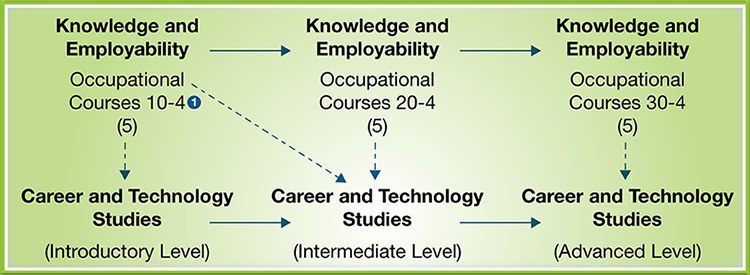Considerations
Considerations for Student Transitions
The following considerations will help identify which students enrolled in K&E courses are most likely to achieve success in making the transition from K&E occupational courses to CTS courses and what strategies will support that transition.
Indicators of Success
Many students make the transition from K&E to CTS after they have completed their Grade 11 or Grade 12 K&E courses and are working toward earning an Alberta High School Diploma. A key indicator of success is students’ performance in the K&E academic courses. Students who demonstrate high levels of success in K&E language arts, mathematics, science and social studies are likely to:
- meet the increased requirements of the CTS program in reading, writing, making calculations and taking measurements
- understand and apply the theory that is fundamental to technical processes.
Transfer Points (Recommended) and Course Sequences Knowledge and Employability Occupational Courses to Career and Technology Studies Courses

![]() Transfer from a 10-4 K&E occupational course directly to an intermediate level CTS course may be considered where there is content relevancy and prerequisite requirements are met.
Transfer from a 10-4 K&E occupational course directly to an intermediate level CTS course may be considered where there is content relevancy and prerequisite requirements are met.
Integrating K&E and CTS
Some students enrolled in K&E courses may be able to achieve success in selected CTS courses; programming can be planned accordingly.
Program Planning Options |
Courses |
Credential Received |
|---|---|---|
| Students enrolled in K&E courses take a combined K&E/CTS program. |
|
|
| Students enrolled in K&E courses may move from K&E (either before or after earning a Certificate of High School Achievement) to a general high school program that emphasizes CTS. |
|
|
Learning Environment
Teachers can help students make a successful transition to CTS by recognizing that the student enrolled in K&E courses may need help in adjusting to a different learning environment. In general, the K&E courses learning environment may be characterized by:
- smaller class sizes, allowing teachers to provide students with individual assistance in building self-esteem and developing specific competencies
- hands-on learning, with minimal reference to occupation-related theory
- the recognition of students’ ability to demonstrate practical skills necessary for success in the specified occupational area
- the awarding of grades based on generic skills development, rather than for the equivalent career-specific competencies in CTS courses
Considerations for Concurrent Program Delivery
Some schools schedule students enrolled in K&E and CTS courses in the same time block and facility. In such circumstances, the following considerations may assist students enrolled in K&E courses in achieving success and assist teachers in managing any challenges these students face.
- Use a combination of CTS and K&E curriculum and learning resources to deliver the required outcomes.
- Clarify each program’s expectations for student performance. Students enrolled in K&E courses are assessed primarily on their ability to demonstrate generic skills in career-specific contexts. Students enrolled in CTS courses are assessed on their ability to demonstrate a set of career-specific competencies to a specified standard.
- Assist students enrolled in K&E courses in developing academic competencies in the areas of language arts and mathematics.
- Recognize that students enrolled in K&E courses may require more practice.